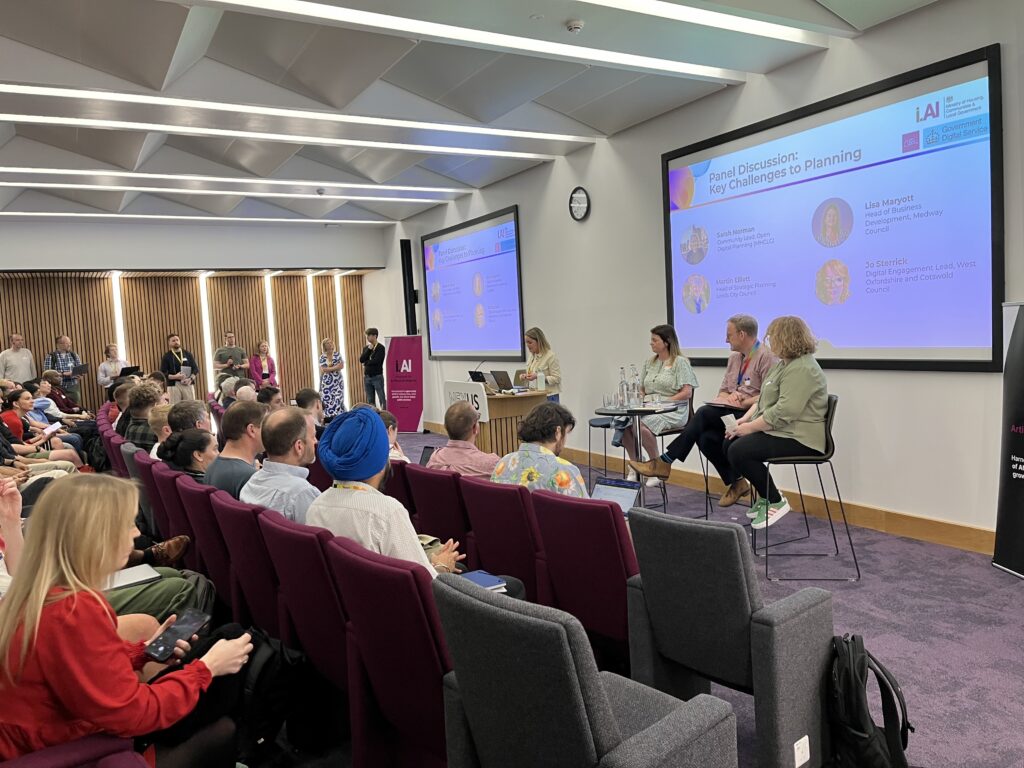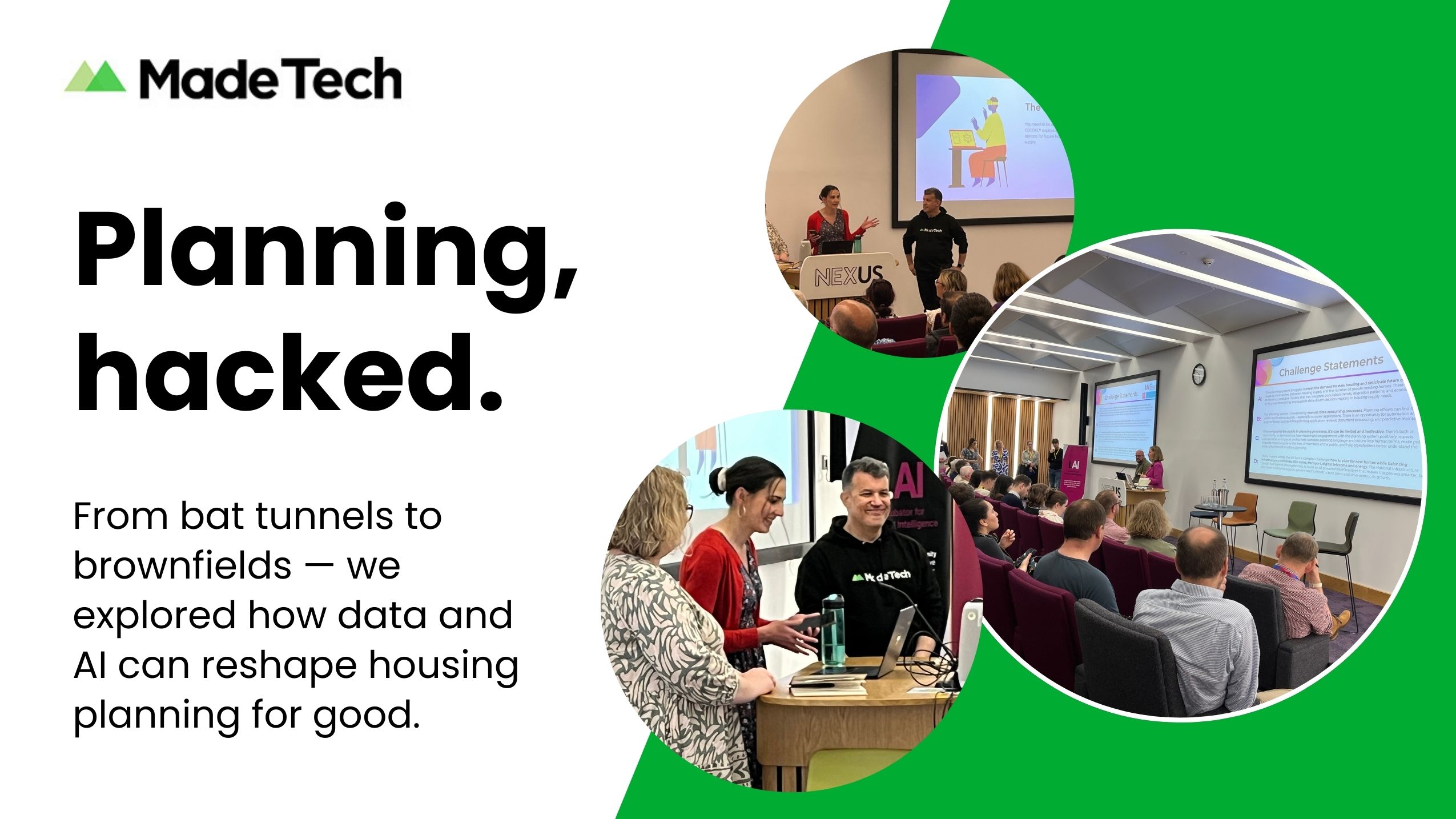NIMBYs (‘not in my back yard’), YIMBYs (‘yes in my back yard’), bat tunnels, green belts, grey belts, brown fields, monstrous carbuncles – the only uncontroversial thing about the planning system is that it’s in trouble. It struggles to balance the twin pressures of opening up opportunities for viable, appropriate development and protecting our heritage, environment and community.
Solving these challenges will take more than policy. It’ll take practical tools that support better, faster decision-making. Software can play a key role in helping planning teams access better data, streamline workflows and design services that actually serve the needs of local communities. While it can’t build consensus or set policy, it can make the process of applying those policies more transparent and more consistent.
Local Government Innovation Hackathon
Our friends at the Ministry of Housing, Communities and Local Government (MHCLG) agree. So, at the end of April I spent an enjoyably exhausting couple of days at their Local Government Innovation Hackathon, hosted at Nexus, University of Leeds, exploring some great ideas for building AI-based tools that could be part of a new, more efficient planning system.
Government Digital Service (GDS) and the Incubator for AI organised the event in partnership with the MHCLG Digital Planning Programme and Open Digital Planning. It brought together a wide range of professionals from across the public and private sectors to have a go at tackling some of the most pressing challenges facing the UK’s planning system. The hackathon gave people the chance to explore and experiment with new ways of delivering modern public services.
Critical challenges within the planning system
Wisely, our hosts focused attendees’ attention on a limited number of critical challenges within the planning system.
- Housing demand forecasting: Can we develop predictive data models that integrate population trends, migration patterns and economic indicators to improve forecasting? This would help councils plan more accurately for future growth and make sure that public investment goes where it’s needed most.
- Planning process automation: How do we address the manual, time-consuming processes that hinder planning officers, particularly when assessing complex planning applications? The goal was to look at automation and AI augmentation to speed up application reviews, document processing and predictive maintenance.
- Public engagement in planning: Can we improve the limited and often ineffective public engagement in planning processes? Is there a way to translate complex planning language and visions into more accessible terms?
- Infrastructure and housing balance: How do we plan for new homes while balancing infrastructure constraints? This would help planners understand the wider implications of planning decisions.
The judges were looking for 3 key things:
Impact
How much the idea could improve the planning system, and whether it could scale and really make a difference.
Innovation
How original, creative, and technically sound the solution was.
Storytelling
How clearly the team explained the problem, the users, and why their solution matters.
Joanna Averley, Chief Planner at MHCLG, led an intimidatingly A-list judging panel
Rapid prototyping
Day one kicked off with registration and a welcome session, followed by an overview of the planning system and the challenge statements. Our team was a motley but well-rounded mix, including developers, data scientists, data engineers, testers, IT leadership and planning support.
Our initial discussions focused on identifying our target persona. In other words, who was our application for? We considered developers, planners, central and local government officials and members of the public. Ultimately we decided to build our solution with the local government official in mind. By 3:30 PM, we had a basic outline of our idea, and we began to build our app.
AWS had provided a team on site to help with technical issues, but they also provided some equally welcome refreshment in the evening, which briefly distracted us before a late finish.
Day 2 was an early start and we worked diligently on our application until the 1 PM deadline. The afternoon was dedicated to presentations and judging.
The presentations were impressive, showcasing a wide range of skills and innovative approaches. The judges were clearly impressed by the effort and ingenuity demonstrated.

Using AI to improve local planning decisions
Our team developed ‘Dwella’. A smart scenario assistant designed to help non-planning specialists (such as local councillors) quickly explore the effects of local changes on housing development plans. We trained our solution specifically on data from the Cotswolds district, but it is adaptable to any planning authority.
Dwella uses Retrieval Augmented Generation techniques to preload locally relevant statistics and policy information into a Large Language Model (LLM), specifically Anthropic Claude Sonnet. This enables a user-friendly, conversational approach to understanding complex planning scenarios. We deployed the application through AWS Bedrock and also had access to forecasting models implemented on AWS Sagemaker. We developed a simple browser-based chat interface to make it easy to use.
Councils could roll out a tool like Dwella, helping save time and resources while giving people more confidence in planning decisions.
Teams demonstrated lots of other great tools at the hackathon. The winner was ‘Clio’. A tool to recover and analyse planning histories for individual sites. This is currently a costly and time-consuming process for planning staff.
What I learned about the planning and housing sector
I’m pretty new to the planning and housing sector and I came away with a number of observations.
- Efficiency is key: Although the second challenge was very clearly focused on efficiency, almost every project focused on improving it. It’s clear that the planning process is often cumbersome and time-consuming for everyone involved, including planning officers, developers, citizens and decision-makers.
- Data skills gap: There’s a real need to educate the planning and local government community about what modern data tools can do and how to use them. Above all, we need to create software solutions that are simple, intuitive, easy to learn and clearly deliver immediate benefit to users.
- Data challenges: The data ecosystem for planning is fragmented and complex. We encountered a wide range of datasets in diverse formats and with diverse standards. Much is unstructured and held within documents. Data discovery is often reliant on lore passed from person to person, although there are valiant attempts such as the Digital Planning Directory which try to address this.
Technically, the main eye-opener for me was Bedrock, the AWS interface for LLMs. I have some experience of building agents and RAG tools, but it was great to see how AWS has provided a useful abstraction layer over the complexities of individual Large Language Models (LLMs). I have some reservations about potential costs and ease of deployment. While it simplifies some aspects, I’m concerned that it might also obscure important configuration details. But we are still very early in the AI revolution and it will be interesting to see how tools like Bedrock evolve.
Hackathon warm-down
It’s called a Hackathon for a reason. Perhaps it wasn’t as gruelling as the London Marathon, but afterwards I felt a happy, exhausted sense of having learned a lot about the planning system and about some tools that might be useful in revolutionising it. Well done, and thank you, to our friends at MHCLG, GDS and i.AI. Let’s do it again, soon.
If you’re curious about how we help government organisations access data more easily and design services that work for real communities, take a look at what Made Tech do with local government here. You might want to browse some of our data and AI case studies too.
The post What happens when you hack the planning system? appeared first on Made Tech.



